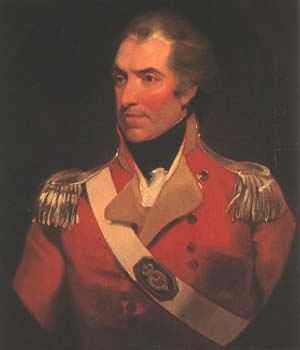William Paterson (explorer) facts for kids
Quick facts for kids
Colonel
William Paterson
|
|
|---|---|
 |
|
| 1st Commandant at Port Dalrymple | |
| In office 16 February 1804 – 24 March 1808 |
|
| Succeeded by | John Brabyn |
| Lieutenant Governor of New South Wales | |
| In office 13 December 1794 – 1 September 1795 |
|
| Preceded by | Francis Grose |
| Succeeded by | Office Vacant |
| In office 24 March 1806 – 26 January 1808 |
|
| Preceded by | Office Vacant |
| Succeeded by | George Johnston |
| Personal details | |
| Born | 17 August 1755 Montrose, Scotland |
| Died | 21 June 1810 (aged 54) At sea aboard HMS Dromedary off Cape Horn |
| Spouse | Elizabeth Driver |
| Military service | |
| Allegiance | United Kingdom |
| Branch/service | British Army |
| Years of service | 1781–1810 |
| Rank | Colonel |
| Unit | 98th Regiment of Foot 73rd Regiment of Foot |
| Commands | New South Wales Corps |
Colonel William Paterson, FRS (17 August 1755 – 21 June 1810) was a Scottish soldier, explorer, Lieutenant Governor and botanist best known for leading early settlement at Port Dalrymple in Tasmania. In 1795, Paterson gave an order that resulted in the massacre of a number of men, women and children, members of the Bediagal tribe.
Early years
A native of Montrose, Scotland, Paterson was interested in botany as a boy and trained in horticulture at Syon in London. Paterson was sent to the Cape Colony by the wealthy and eccentric Countess of Strathmore to collect plants, he arrived in Table Bay on board the "Houghton" in May 1777. He made four trips into the interior between May 1777 and March 1780, when he departed. In 1789 Paterson published Narrative of Four Journeys into the Country of the Hottentots and Caffraria, which he dedicated to Sir Joseph Banks.
Career
Paterson was originally commissioned as an ensign in the 98th Regiment of Foot and served in India. He later transferred to the 73rd Regiment of Foot after the 98th's disbandment in 1787. In 1789, he was promoted to captain in the New South Wales Corps, serving under Major Francis Grose. After some time spent recruiting, he arrived in Sydney in October 1791. From November 1791 until March 1793 he served in command on Norfolk Island. Whilst there he collected botanical, geological and insect specimens and sent them to Banks. He also provided seed to the Lee and Kennedy and Colvill nurseries. He was elected a Fellow of the Royal Society in May 1798.
In 1794 he served for a year as Lieutenant Governor of New South Wales. In 1800 he was re-appointed to the post and served a second term until 1808.
In May 1795, following the alleged killing of two settlers Paterson ordered two officers and 66 soldiers to:
destroy as many (Aboriginal Australians) as they could meet with ... in the hope of striking terror, to erect gibbets in different places, whereon the bodies of all they might kill were to be hung ...
Seven or eight Bediagal people were killed. A crippled man, some children and five women (one being heavily pregnant) were taken to Sydney as prisoners. One of the women and her baby had serious gunshot wounds. The child died not long after as did the newborn baby of the pregnant woman.
In 1801, Paterson fought a duel with John Macarthur and was wounded in the shoulder.
He led an expedition to the Hunter Region in 1801 and up the Paterson River (later named in his honour by Governor King). The expedition discovered coal in the area that would later become the vast South Maitland Coalfields; it was a discovery of great economic significance. In 1804, he led an expedition to Port Dalrymple, in what is now Tasmania, exploring the Tamar River and going up the North Esk River farther than European had previously gone.
Between 1804 and 1808 Paterson was also appointed Commandant at Port Dalrymple, the administrator of the colony in the north of Van Diemen's Land. In 1806, Paterson's duties as commander of the New South Wales Corps required him to return to Sydney, but he went back to Van Diemen's Land in 1807, and stayed until December 1808. During this time he corresponded regularly with the eminent naturalist Sir Joseph Banks, sending a number of specimens.
The New South Wales Corps selected Paterson as acting Governor of New South Wales on 1 January 1809 after the deposition of Governor Captain William Bligh in the so-called "Rum Rebellion." He was replaced by the newly arrived Lachlan Macquarie by the end of the year. He left Sydney for England on 12 May 1810, but died on board HMS Dromedary while off Cape Horn just a few weeks later.
His widow Elizabeth married Francis Grose, Paterson's predecessor as Lieutenant Governor, in April 1814, but Grose died a month later. Elizabeth died in Liverpool, England in 1839.

